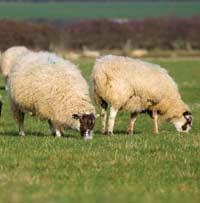Irish sheep conference shows benefits of EID

Strategic use of creep feed, attention to grassland management and the use of EID as a management tool, were the talking points at the recent Irish Grassland Association Sheep Conference, County Kilkenny, Ireland
A demonstration of EID technology, used to collect data for a new Irish sheep genetic index, proved it could be put to good use and may be an essential tool for big sheep farmers looking to improve health and breeding records.
Crosby Cleland, Farmers Weekly Sheep Farmer of the Year, has long recognised how EID can be used in a practical sense for some commercial sheep farmers. “I have been using EID alongside an auto-draft system at my farm in County Down for several years with great success.
“There is no doubt EID should be a voluntary scheme, but it can prove an invaluable tool for larger flocks with more than 400 ewes or the smaller pedigree enterprise,” said Mr Cleland.
“Prior to installing our system, we were manually recording numbers and information, which was hugely time consuming. Putting in the technology cost about £8000, which was easily paid back in labour savings.”
The system had allowed him to improve flock genetics and helped in scrapie monitoring. “To export to southern Ireland I need to do a lot of book work to prove our scrapie status. This system automatically records and prints off a list, which saves time significantly.”
The big guys could definitely get extra value from installing EID and extra kit on farm, agreed Patrick Donnellan, Irish Cattle Breeder Federation. “This extra technology has advantages in terms of handling and drafting for the big producer of 300-400 sheep.
“But there is no doubt introducing EID for small flocks based on traceability is overkill,” he said.
“The only way the small farmer can see the full advantage of EID is when the whole industry is hooked up so there is feedback along the supply chain, thereby getting information on how individual progeny performed.”
Boosting growth rates
Sheep farmers were becoming too reliant on concentrates to achieve high lamb growth rates, said Michael McHugh.
“In this economic climate and with current lamb prices, sheep farmers must concentrate on improving grass quality and incorporating clover to reduce dependency on concentrate feeding.”
“On average, 36% of total variable costs for Irish flocks come from concentrate use,” said Mr McHugh. “Many farmers are opting to feed creep to finish lambs earlier and avoid price falls in the market due to late finishing.”
Strategic use of concentrates may be necessary to finish tail enders, but spending on concentrates should be reduced to 20% of variable costs, achieving this target was worth up to €100/ha.
“With good grassland management you can get mid-season lambs to finishing weights without supplementary feeding.”
Forward creep grazing, by grazing lambs on high grass covers in front of ewes, may be the answer. “This can increase lamb weaning weights by 2kg and allows tight grazing of pastures in June, without reducing lamb thrive. This will also maintain grass quality for post-weaning grazing in July,” said Mr McHugh.
Post-weaning lamb-thrive could also be maximised by close grass management. “A target post-weaning growth rate on grass-fed lambs is 150g a day. This can be achieved by grazing at a pasture height of 9cm down to 6cm in rotational grazing.” Grazing pasture tightly in early June keeps grass leafy and improves lamb growth post-weaning.”
But where target drafting dates were not being achieved, it may be necessary to feed concentrates to compensate for poor performance. “But intakes should be controlled to a maximum of 25kg a lamb,” he said. “Lamb health and grass quality are key to reducing the need for creep feeding.”
The best response to creep was achieved at low feeding levels. “Enhance the response to creep by encouraging lambs to creep graze and limit creep to a maximum 300-400g a lamb a day.”
Creep feeding could bring forward slaughter dates by 32 days compared with gras-fed lambs. But despite this extra performance in liveweight gain, the margin from feeding was small and could be a substantial cost unless feed was cheap, he added.
But creep can be used strategically to bring forward finishing dates when prices were high and likely to fall. Good results could be achieved by using simple, inexpensive rations containing cereals.
